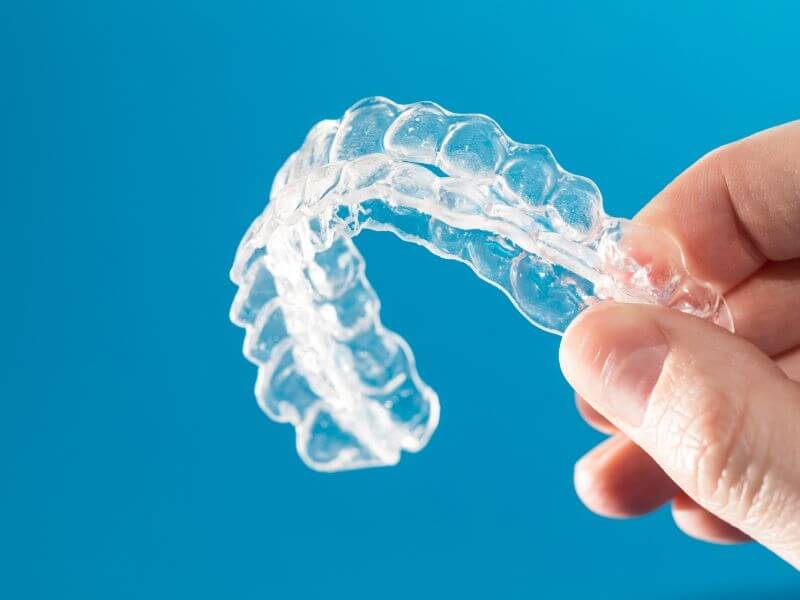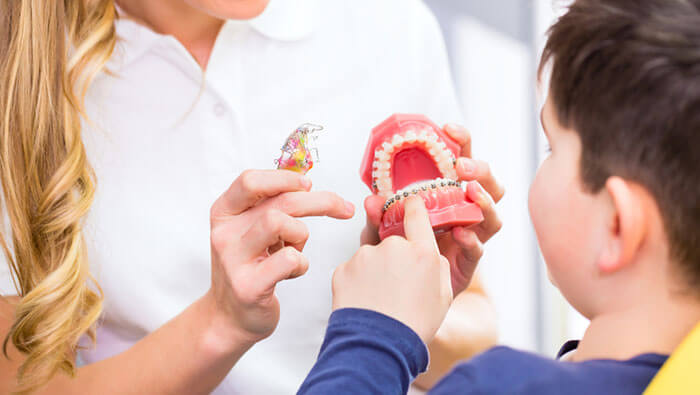Whether you are looking to improve the look of your smile, or to treat dental misalignments or other functional concerns, the main treatment option your orthodontist turns to is braces. When people think of braces, they often think of traditional metal braces covering the teeth. But that’s not your only option. Oftentimes, your orthodontist may recommend non-traditional braces to treat your concerns and help improve your smile.
Key Takeaways
- Braces are used to treat dental misalignments and improve smiles.
- Different types of braces include traditional metal braces, self-ligating braces, lingual braces, ceramic braces, and clear/removable braces (such as Invisalign).
- Traditional metal braces are the least expensive and most effective, but most noticeable.
- Self-ligating braces have brackets with a spring-loaded door, reducing the need for elastic bands and making adjustments quicker.
- Lingual braces are placed on the inside of the teeth, making them virtually invisible but less effective and more difficult to clean.

Why do you need braces?
Braces are a highly effective treatment option designed to adjust and repair a variety of dental concerns, all while helping to improve your smile. While traditional metal braces were the only option for many years, advances in dentistry now offer many different treatment options. Your unique dental concerns play a role in determining which type of braces will provide you with the best results.
How do you know if you need braces?
At Soundview Family Dental, we recommend that you see your dentist every six months for regular dental exams, starting at an early age. This allows the dentist to closely monitor your dental health and evaluate any potential concerns that may require orthodontic treatment with braces. While treatment with braces during childhood is best for some concerns, many orthodontic treatments require the loss of all baby teeth first.
Some common conditions addressed by braces include:
- Crowded teeth
- Missing teeth or increased space between teeth
- Overbites or underbites
- Teeth that do not align or meet correctly
- Disproportion of the jaw or teeth
- Incorrect jaw position
- Jaw disorders
- Difficulty chewing food due to improper dental alignment
- Breathing issues
- Early or late baby teeth development
- Late or delayed adult teeth development

Different types of braces?
As we have mentioned, orthodontic treatment with braces goes far beyond the idea of traditional metal braces. While metal braces are still the best treatment option for some conditions, there are a variety of different options available. Together, with your orthodontist, you will decide which type of braces will work best for you. This can include any of the following options.
Traditional metal braces
Traditional metal braces use metal brackets that attach directly to the teeth. Wire then attaches to each bracket by the use of elastic bands. During your treatment, the orthodontist adjusts the wires and replaces the bands to slowly move your teeth into the desired location. Traditional metal braces are typically the least expensive treatment option, while often being the most effective. Despite the development of new treatment options, metal braces are still the option most used for treatment. Unfortunately, they are also the most noticeable treatment option. This leaves many people self-conscious about their appearance and looking for alternative treatment options. Additionally, because these brackets attach directly to your teeth, you must use caution with certain foods, such as hard candy or sticky foods, as they can damage the brackets and wires.
Self-ligating braces
Self-ligating braces are similar to both traditional and ceramic braces, but with a slight twist. While metal and ceramic braces utilize elastic bands to attach the wire to the brackets, the brackets used with self-ligating braces have a spring-loaded door that holds the wire in place. This eliminates the need for elastic bands and can make adjustments quicker and easier for the orthodontist. The elimination of elastic reduces the risk of trapped food which can contribute to plaque formation. In addition, self-ligating brackets can either be metal or clear, offering a less visible option. However, while the brackets can be clear, the wire is still traditional metal.
Lingual braces
Lingual braces are like traditional braces and use metal brackets and wires. The only difference is these braces go on the inside of the teeth, making them virtually invisible. While more aesthetically pleasing, these braces are less effective and unable to treat more serious alignment concerns. They can also cause discomfort for some as they come in direct contact with the tongue. Because of their placement, they are also more difficult to clean and maintain. They can also make eating difficult and certain foods can cause damage.
Ceramic braces
Ceramic braces work in the same manner as traditional metal braces. The only difference is that instead of metal brackets attached to each tooth, the brackets are made from a ceramic material designed to blend with the natural color of your teeth. In some cases, even the wires used can match your natural tooth color. This makes them much less noticeable. Unfortunately, this difference also makes them much more expensive than traditional braces. Additionally, if you do not thoroughly clean and care for the brackets during treatment, they may become discolored and stained. Like traditional braces, you must also avoid certain foods that can damage your brackets and wires.
Clear and removable braces
Clear and removable braces, such as the brand Invisalign, are a completely different option for orthodontic treatment. While the previous braces we mentioned attach directly to your teeth, this option does not. Instead, these types of braces use a series of custom-fit clear plastic aligners that you place over your teeth. You can remove them to eat and to clean your teeth. Every two weeks or more throughout your treatment period, you replace the aligner with a slightly different aligner designed to slowly move your teeth into the desired position. These differences make them more appealing to many as they are invisible to others and they allow you to eat and drink anything you choose without the risk of damage.
Unfortunately, while these may seem like the ideal option, there are disadvantages associated with clear aligners. They can only correct minor to moderate dental concerns, and are only available for teenagers and adults – not younger children. Because you can remove these aligners, there is the risk of accidental loss, and replacement aligners can be costly. The fact that you can remove the aligners also increases your responsibility for treatment. You must always wear the aligners, aside from eating and cleaning. Forgetting to wear an aligner for a day or longer can increase the duration needed for your treatment.
Making the decision to start orthodontic treatment with braces
When your dentist recommends a consultation with an orthodontist, knowing your options for braces allows you to work with them to determine which treatment option will work best for you. While each available form of braces cannot treat every condition, in many cases, you do have options and your orthodontist will work with you to find the braces that fit your needs.


